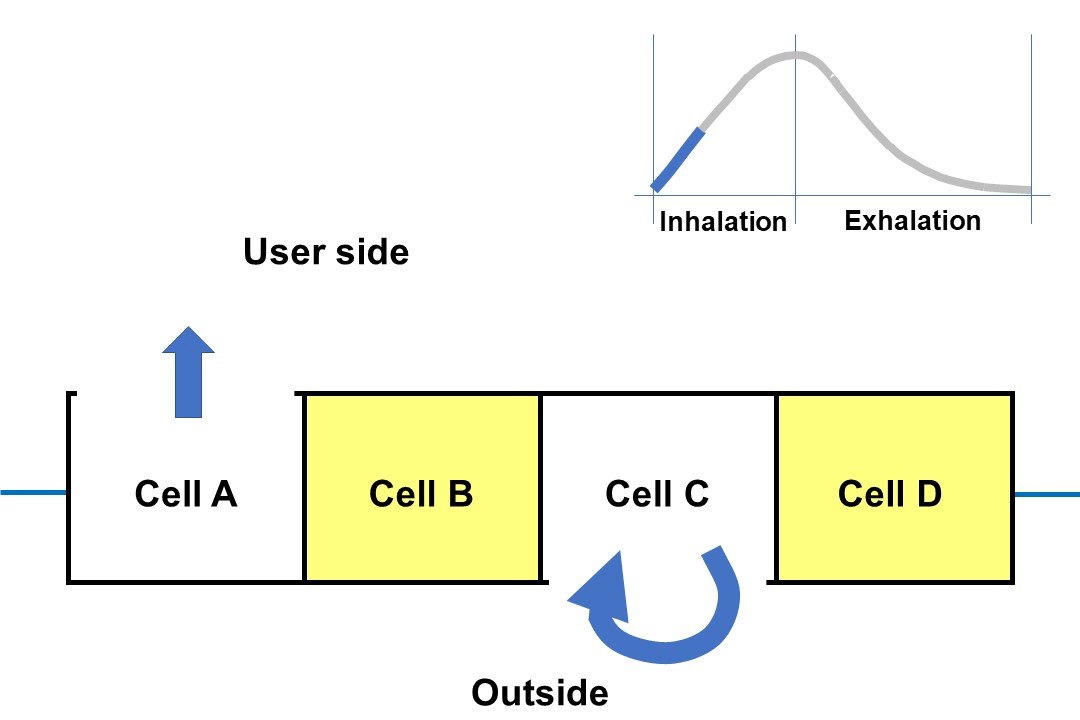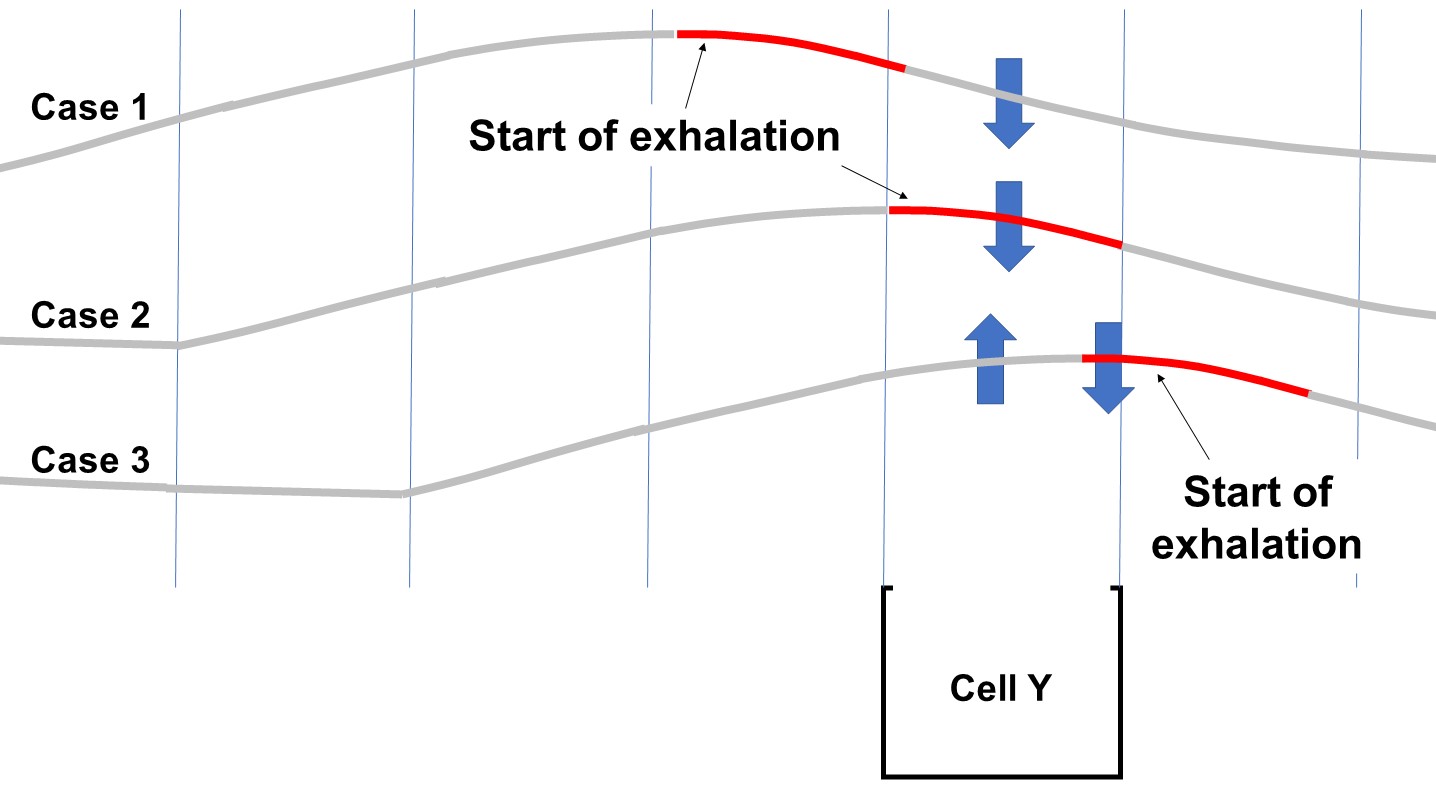Intellectual Property
For the invention of this germicidal filter, the INPI (National Institute of Industrial Property / french patent office) granted 1ventive with a patent in France. This patent (FR3115697B1) is referenced in patent databases, such as Google Patents, Espacenet or Patentscope, where it is possible to translate the text into the language of your choice.
Download the patent FR3115697B1 (granted in France)
This patent is also published by the WIPO (World Intellectual Property Organization) with reference WO2022/258531A1.
Download the international publication WO2022/258531A1
1ventive does not intend to directly use this invention, so we are open to transfer all the Intellectual Property rights of the granted patent FR3115697B1 (contact).
Principle
This germicidal filter makes it possible to sanitize a volume of gas by fragmenting it into segments, by physically isolating each segment from the other segments, by exposing each segment to UV-C radiation to disinfect it, then by releasing each segment thus exposed. All operations of this germicidal filter are sequential and executed in “pipeline mode” to ensure a continuous gas flow at the outlet. This invention allows to treat a flow circulating in a given direction, or alternately two flows of opposite directions.

Disinfection is carried out by exposure to short-wavelength ultraviolet radiation also called UV-C, which is suitable for inactivating microorganisms (viruses, bacteria, etc.). Each gas segment is disinfected with UV-C in a cell, only when the gates of this cell are closed :
- thus ensuring control of the UV-C dose (volume of gas treated, and duration of disinfection) applied to each gas molecule of the segment,
- thus preventing UV-C propagation outside of the cell, UV-C being harmful to human body.
Note : the patent mentions that although the invention has been more particularly described in the context of a box comprising four cells, the invention applies in the same way for at least two cells. Consequently, if necessary for the application, the number of cells can therefore be greater than four
Using the germicidal filter for air flow treatments :
This germicidal filter used in one-way mode allows to renew the air in an air conditioner, a passenger compartment, an enclosure, a room, etc… by blowing disinfected air, or by extracting contaminated air. In order to adapt to the configuration, the filter parameters can be adjusted to smoothly treat the required air flow : number of cells, volume of cells, segmentation rate, power of UV-C radiation, … the operation being carried out in complete safety for the vicinity of the filter.

Using the germicidal filter with a breathing mask :
This germicidal filter used in combination with a protective mask constitutes an individual equipment allowing the air alternately inhaled and exhaled by the user to be disinfected :

The human breathing cycle lasts about 4 to 5 seconds. This cycle is divided approximately in 1/3 for inhalation and 2/3 for exhalation. During the inhalation period, a drop in pressure occurs, then a brief balanced period without air movement, followed by a period of exhalation with an increase in pressure generated by the air expelled from the lungs. This exhalation of air is decreases gradually and is extended by a pause without air movement before the start of a new cycle. The volume of inhaled or exhaled air is approximately 500 cm3 every 2 seconds.

In the example shown above, the sequencing rate of the filter operations is 500 ms, so that the drop in pressure caused during the 1.5 s period of inhalation reassembles three segments of sterilized air successively sucked from three cells, then the overpressure generated during the 2.5 s period of exhalation pushes the exhaled air towards five successively open cells in order to disinfect the fragmented air flow after cells closure. This simplified example shows the principle of operations. There is no reason to have filter sequencing synchronous and in phase with breathing. In practice, the start of inhalation and the start of exhalation may appear at different times of the operations.
– Start of inhalation :

The start of inhalation can occur simultaneously with the opening of cell X towards the user (case 2). The user then inhales all of the air that has been previously sterilized in the cell. In case 1, where the inhalation started with another cell before the opening of cell X, the inhalation continues with cell X in a similar way to case 2. If the inhalation starts after the opening cell X (case 3), the contents of the cell is mainly made of previously sterilized air since it has not yet been emptied (the previous exhalation ends with a pause without movement of air following a gradual attenuation).
– Start of exhalation :

The start of exhalation can occur simultaneously with the opening of cell Y towards the user (case 2). The user then fills the cell with exhaled air, then the contents of the cell will be sterilized before rejection to the outside. In case 1, where the exhalation started before the opening of the Y cell, the exhalation continues with cell Y in a similar way to case 2. If the exhalation starts after the opening of the cell (case 3), the cell is then almost empty since it is the end of the previous inhalation followed by a brief balanced moment without air movement.
Synchronization between the user’s breathing and the sequencing of the filter’s operations is therefore not essential. Moreover, the germicidal filter is compatible with different breathing rhythms. In the example below the user breathes four times faster:

The degree of microorganisms’ inactivation at one place is directly related to the UV-C dose applied which is the product of the UV-C source power and exposure time [T] and following the inverse square law of the distance from the UV-C source. In other words, the UV-C efficiency is significantly increasing while the distance decreases from the source. It is therefore possible to improve the disinfection effectiveness by raising the power level of the UV-C radiations, or by increasing for each cell the UV-C exposure duration of the air segments and by reducing the volume of each cell, in return it will be necessary to increase the number of cells and to adapt the sequencing of the operations.
Such a filter based on UV-C radiation centered on the 254 nm wavelength has germicidal properties while not producing ozone that can cause respiratory problems. Not only does 254 nm UV-C radiation disinfect the air passing through it, but it also breaks down the ozone (O3) molecules into oxygen (O2) molecules. A respiratory mask equipped with this filter can be used to protect the user and his entourage in a context of decontamination, but it can also be used to protect the user in an ozone-rich atmosphere by reducing the concentration of ozone in the air inhaled through the filter.
Economical aspect
A protective mask equipped with a UV-C germicidal filter is more expensive per unit than a simple disposable mask. An objective comparison of costs must be made over a long period: a professional user must use at least two disposable masks daily, whereas a mask comprising a UV-C germicidal filter is reusable, and each time without time limit since disinfection is continuous. Over time, the investment in a mask with a germicidal filter becomes more economically profitable for the user than the use of disposable masks and also constitutes an eco-responsible approach.
Summary of benefits
- Germicidal filter allows to treat a gas flow circulating in a given direction, or alternately two flows of opposite directions,
- Fluent gas flow at the outlet (at any time one cell is open for input and output),
- Minimization of health risks (UV-C applied only in closed cells),
- Depletion of ozone concentration in the air during transit through the filter,
- In the case of use with a mask :
- Compatible with different breathing rhythms,
- Protection of the user and of people around (treatment of inhaled and exhaled air),
- Configurable filter (UV-C radiated power level, number and volume of cells, sequencing rate of segmentation operations).

